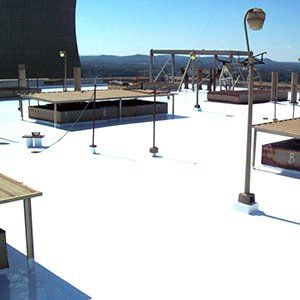"Cool", White Roofing
Cool, White, Reflective Roofing

Energy Savings through Roof Restoration
White, highly reflective roof membranes and coatings have been proven to save building owners thousands of dollars annually on their energy costs. The high level of solar reflectance has been proven to reduce energy consumption, abate urban heat island effects and help slow the formation of smog forming pollutants.
With a white, highly reflective roof, roof top HVAC units no longer intake 178+ degrees F temperatures. The outside air supply is now only 98 degrees F that needs to be cooled. It requires less energy to cool this air to the desired interior temperature, thus saving the building owner money and conserving energy.
Upgrading/increasing roof insulation will increase the system R-value and increase the overall energy efficiency and cost-savings for your building. When looking to upgrade your roof system to a white, highly reflective membrane or coating, make sure to evaluate the existing insulation system.
For information on
Study Proves White Thermoplastic Roof Saves Money
In a two-year scientific study, commissioned by the U.S. Department of Energy (DOE) and the Environmental Protection Agency (EPA), researchers at the Lawrence Berkeley National Laboratory set out to monitor and verify summertime air conditioning savings and peak electrical demand reduction at a 100,000 square foot retail establishment in Austin, Texas. Building temperatures and energy usage was monitored for a period of 1 year with the existing black rubber EPDM roof. The roof was then replaced with a white, reflective Sarnafil roof membrane and the test was run again during the same time of year as the previous test. Below are the results:
- Total annual air-conditioning savings were estimated to be $7,200 or 7.2 cents per square foot. This does not include savings from taxes or other utility charges.
- The estimated saving over the lifetime of the membrane was calculated to be between $62,000 and $71,000 (present value). This was based on an industry average of 13 years for a single-ply roof membrane. Sika Sarnafil roof systems have been proven to last much longer than this, further increasing the store
